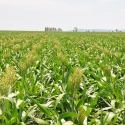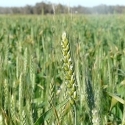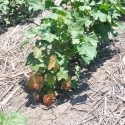13 Feb 2011
Keeping an eye on zinc levels
Keeping an eye on zinc levels
By Rob Norton, Regional Director, Australia & New Zealand – International Plant Nutrition Institute
As well as being an essential element in plant nutrition, zinc plays a key role in human nutrition. Zinc is a particular problem for people on grain-based diets with little or no seafood or vegetables. This generally encompasses the poorest people on earth. UNICEF estimates that more than 400,000 children die each year due to zinc deficiency.
So important is this problem, that the international Consultative Group on International Agricultural Research (CGIAR) established the ‘Harvest Plus’ program (See www.harvestplus.org for more information) in 2003 to address strategies to improve grain zinc, as well as iron and vitamin A in human diets.
The key strategy for maintaining zinc levels in the human diet is to ensure adequate fertiliser zinc is applied, along with selection of wheat cultivars that are efficient at taking up zinc.
Meeting the challenge
The Harvest Plus project has set a preliminary target of at least 33 mg/kg of zinc in wheat to ensure a healthy diet.
It has been recognised for a long time that much of the Australian grain zone is low in soil zinc with the consequence that grain zinc levels are also low.
As part of an International Plant Nutrition Institute (IPNI) global wheat project, grain micronutrient levels, including zinc, were analysed from grain taken from 70 National Variety Trials (NVT) sites used in the GRDC southern region in 2008 and 2009.
Most of these sites, especially on alkaline soils, received zinc supplements with the fertiliser applied at sowing.
A summary of these results, (see Table 1) show the mean grain zinc content in mg/kg (or parts per million) for the various production regions. Also shown is the sort of normal range, or standard error (±)) for zinc for each region.
Table 1: Grain zinc contents from 70 NVT sites in New South Wales , South Australia and Victoria (IPNI).
State | Region | Zn (mg/kg) |
NSW | South East | 23.0±2.4 |
South West | 23.5±2.4 | |
SA | Lower EP | 18.7±2.0 |
Mid North | 25.4±1.8 | |
Murray Mallee | 19.2±1.6 | |
South East | 24.5±2.2 | |
Upper EP | 26.0±1.4 | |
Yorke Penn. | 22.2±2.0 | |
Vic | Mallee | 18.9±1.7 |
North Central | 25.5±3.4 | |
North East | 28.8±3.4 | |
Wimmera | 27.3±2.2 | |
Total | Mean | 23.0±7.3 |
In all regions, mean grain zinc levels are less than the 33 mg/kg target, and in the Lower Eyre Peninsula, and the Victorian and South Australia Mallee mean levels are around half the Harvest Plus target.
IPNI also analysed grain from other countries and Australian values were at the lower limits of grain from other countries, such as Canada (48 mg/kg), Russia (27 mg/kg) and India (48 mg/kg).
Applying zinc at sowing
The use of zinc fortified fertilisers at sowing is an effective way to raise grain zinc levels.
Research over the past has shown that grain yield responses can be seen, although it is much more likely to get increases in grain zinc.
For example, Peck et al. (2008) reported grain yield responses on three of six sites to 7.5 kg Zn/ha at seeding, but saw grain zinc increase on five of the six sites. (See Figure 1)
Figure 1: Yield and grain response to zinc fertiliser at sowing
Response of wheat yield and grain zinc concentration to 7.5 kg Zn at seeding for six sites in southeastern Australia. Source: Peck et al. 2008, J. Cereal Science, 47, 266-274
For germinating seedlings, a supply of zinc from the seed is important for good seedling vigour. Seed with less than around 500 ng/seed are likely to have slow establishment unless supplementary zinc is available at seeding.
Seed zinc content and zinc concentration are often, but not necessarily, related. For example, one seed sample from Kimba in the Upper Eyre Peninsula in SA had a grain zinc level of 27 mg/kg, but the relatively small seed meant that there was 520 ng/seed.
From the NVT data set, the mean seed zinc content was 770 ng/seed, which should be adequate. There were samples that had levels less than 500 ng/seed, and the lowest was 285 ng/seed, and most low values were from areas with alkaline, calcareous soils. Application of zinc to crops to be kept for seed will ensure good quality for the next season.
Checking zinc levels
Soil testing for zinc using the DTPA extraction method has limited diagnostic value, but it is likely to identify extremely deficient soils. Plant tissue testing may be of some value, and advice from a Fertcare® accredited adviser is important to collect and interpret this test.




